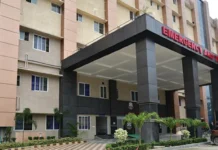[ Ranjit Sinha ]
The Arunachal Pradesh Literary Society (APLS) has become a literary force to be reckoned with. Within a decade, the Society has made a mark in the land of the Rising Sun not only in nurturing the budding literary talents, but has also succeeded in promoting bond of unity between the people of neighbouring states of Assam and Arunachal Pradesh through its literary activities.
Though successive state governments have evinced keen interest in the activities of the APLS, it was during the tenure of Chief Minister Nabam Tuki that the Society got a new lease of life.
Tuki, an ardent admirer of legendary singer and writer Dr Bhupen Hazarika, felt the pulse of the Society (APLS).
As a result, with the rigorous persuasion of the APLS, the state government had sanctioned an amount of Rs 30 lakh during 2015 and accordingly, the government fulfilled its commitment by erecting a statue of Dr Hazarika at a plot of land donated by the sons of erstwhile Provisional Legislative Assembly Member, Gora Pertin at Bolung village in Dibang Valley district.
Earlier, the APLS had collaborated with Asom Sahitya Sabha and instituted Lummer Dai Sahitya Award, besides establishing the Lummer Dai Distance Learning and Tribal Research Centre at Bihupuria in Assam.
It had also succeeded to convince NEEPCO, a government-public sector enterprise, to institute an award for established litterateurs of the state under its social responsibility schemes.
Apart from this, the Society brought many eminent writers of the state in the forefront. Perhaps, one of the first Hindi writers of the state, Jumsi Siram would have banished into oblivion had the Society not honoured him and recognized his creative literary activities.
What is most amazing is its regular feature – multi-lingual writers meet, which provides a platform for both indigenous people of the state and people from outside, who are contributing in state’s development in various capacities, to showcase their talents in literary activities.
Even though the APLS is thriving with its mission and vision, there is an apprehension about the future of literary activities without a rigorous movement on preservation of indigenous dialects or languages, which are fundamental needs for expression of any thoughts for any creative activities -be it literature or scientific invention.
The UNESCO in its report in 2009 had already identified 26 languages of the Arunachal Pradesh as endangered.
Needless to say, like any other social activist, a creative writer has the responsibility to preserve the identity of a community through literary works with indigenous flavour.
Will the APLS put its force to spread its tentacles in every nook and corner of the state for promotion of a sense of loyalty among all indigenous people towards own languages or dialects? Will it be a powerful motivational platform for young generation to promote the culture and tradition of tribal society through writings?





